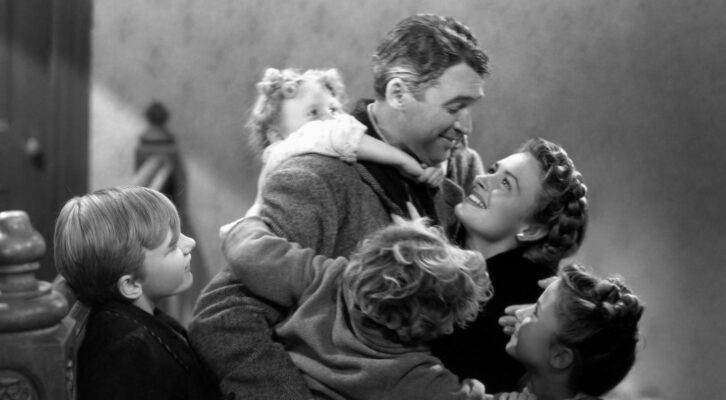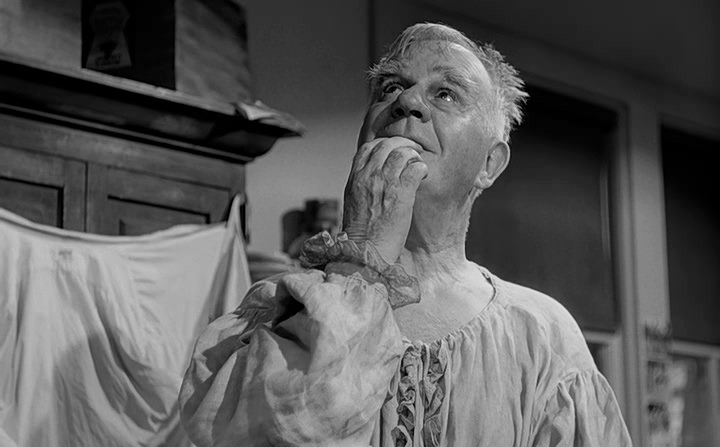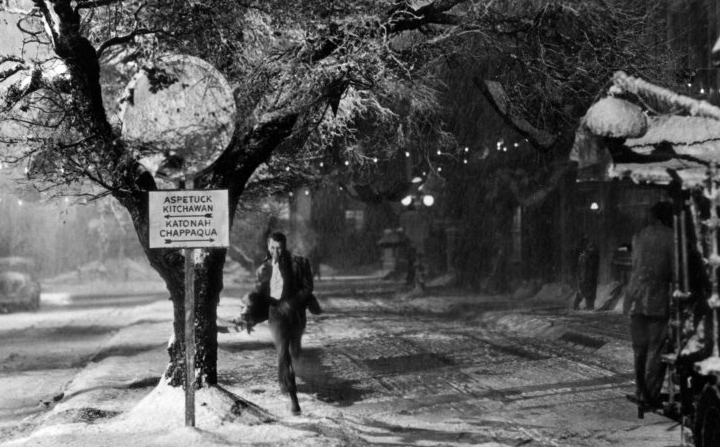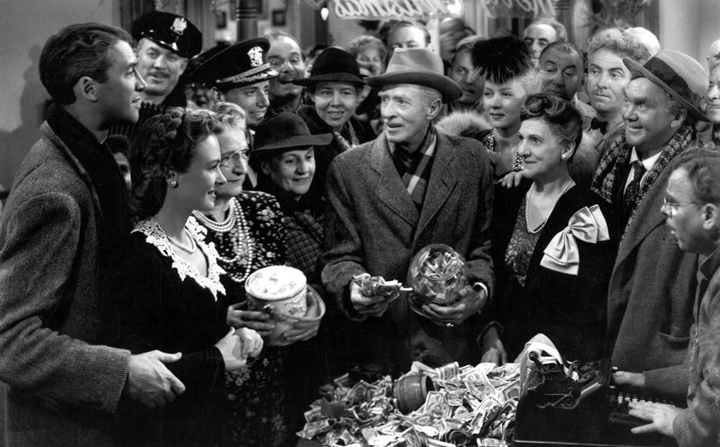
Real Gratitude Shouldn't Be Easy: On It's a Wonderful Life
George Bailey Rejects the Given in Favor of the Good
Like many people without a particular religious creed, I’ve imagined Heaven in a variety of ways over my lifetime. As a kid, I pictured it as a giant ball pit, like the ones you see at Chuck E. Cheese, though ruled by neither God nor animatronic rodents. As a bigger kid, I imagined it as an infinity pool that no one ever peed in. But now that I’m an adult—now that I’ve seen Frank Capra’s 1946 film It’s A Wonderful Life countless times—I can only imagine Heaven as a thankless military bureaucracy.
Consider Clarence, the AS-2, or “angel, second-class” played by the character actor Henry Travers. When first we see him, he’s been dispatched by God to squire Jimmy Stewart through visions of a yuletide netherworld. He strikes us as perhaps a little homely for Heaven, with his gentle Muppet face and billowy eyebrows. His clothes look thrifty, even threadbare. He has a single shirt to his name—the same one he died in—and a single ambition: to gain a rank and his proverbial wings. Practically speaking, this means he has to work on Christmas.

Perhaps this fixation is depressing, but It’s a Wonderful Life is often a depressing movie. A family film about suicidal ideation, it follows a loan officer named George Bailey, played with easy charm and toxic bile by Stewart. George’s childhood, like his adulthood, is blighted by humiliation. Kids scream at him: go to work, slave! Adults slap him until his ears bleed. He grows up and dreams of going to college, or to Europe, or anywhere at all. Out of loyalty to his father, he takes over the family business, the Bailey Building and Loan. Out of intense sexual frustration, he marries a college freshman played by Donna Reed. He has a carload of children, perhaps out of necessity. He never goes to college, or to Europe, and a childhood accident prevents him even from going to war. At best, he might go to prison, after a bungling relative implicates him in a financial scandal.
Which brings us to Clarence, and the movie’s famous fantasy sequence. On a snowy Christmas night, George stares down into black waters and contemplates suicide. Suddenly, Clarence appears, standing beside him with a menacing closeness. To restore George’s faith in life, Clarence shows him what the world would be like had he never been born. There, he encounters his wife transformed—horror of horrors!—into a librarian. The virtuous Bedford Falls, renamed Potterville, is a hotbed of drinking and gambling. His neighbors are drunks and delinquents, possibly prostitutes. Following this grim vision, George, like Scrooge before him, is reformed. Rather than jumping from the bridge, he runs hatless through the town, proclaiming his love to all manner of people and places: “Merry Christmas, Ernie!” “Merry Christmas, Library!”

The sentimentality here is shameless and characteristic Capra. His other most famous films also sing the virtues of little lives in little places—think of Jimmy Stewart’s first tortured turn as the title character and political neophyte in Mr. Smith Goes to Washington. And while I’m unfailingly delighted by his screaming, “Merry Christmas, you wonderful Building and Loan,” the scene often strikes me as a moralizing Goodnight Moon, with George naming all the institutions that have tethered him to his mediocrity and misery. What restores George’s optimism in this scene isn’t a sudden recollection of life’s pleasures, but the fear of how much worse it could be. It’s the suggestion that life is a duty rather than a joy, wearily performed for the benefit of others.
This, too, is true Capra. For all their unvarnished sentiment, his movies paint the world over with cynicism. In Capra’s vision, even life in heaven is a poisoned by ambition, while life on Earth is harried by greed and corruption. The film, perhaps, is more about thanklessness than gratitude. George, despite his Eagle Scout earnestness, still needs divine intervention to appreciate his life. So, too, does he need to make a soul-journey into the nightmare world where friends and family have been plunged into unwitting, perpetual mourning. These scenes are animated by a gentle sadism, and a belief that perverse tours of the imagination can soothe the spirit. Perhaps this is true. At our frequent worst, gratitude isn’t something we feel so much as calculate, tallying our advantages to weigh against the miseries of others. In the privacy of our own minds, our gratitude can bear a family resemblance to schadenfreude—a secret reassurance that others will always have it worse.
But, as I have watched and rewatched the film, it seems to me that Capra’s point is that real gratitude should be difficult. Consider the scene about halfway through the movie when the wicked financer Mr. Potter, played by Lionel Barrymore, offers to hire George at a salary of $10,000 a year. The offer, we know, is in bad faith—a ploy to wipe out the Bailey Building and Loan, so Potter can further exploit the working classes without the interference of liberal-minded competitors. For a moment, though, George forgets himself. He considers the offer, flush with the possibilities of wealth, travel, prestige. And then—and not for the last time—he is restored to himself. He remembers that Potter, simpering across his giant desk like a malevolent Winston Churchill, is a fat-cat and a crony. “You’re a warped, frustrated old man,” George fumes, and recalls his father: he “was no businessman, but he died a richer man than you’ll ever be!”
“In the privacy of our own minds, our gratitude can bear a family resemblance to schadenfreude—a secret reassurance that others will always have it worse.”
Is George ungrateful for refusing Potter’s offer? Certainly Potter thinks so. But to me, it’s this moment in the film—not George’s spree through Bedford Falls, not the film’s tearjerking, caroling conclusion—which best embodies gratitude as an ideal. In his showdown with Potter, George illustrates the difference between two types of gratitude—the kind that’s selfish, and the kind that’s “rigorous and inclusive,” in the words of Barbara Ehrenreich. Often, the suggestion to be grateful can sound like a suggestion to be complacent: to accept thing as they are, because they could always be worse; to accept what we’re given, lest we get even less. As Ehrenreich wrote in a 2016 op-ed for the New York Times, this is the gratitude preached by celebrities and pop psychology, and which is, at bottom, a form of “self-love.” But in Potter’s office, we see gratitude practiced not as the love of oneself but as a love of others. We see someone refuse the given in favor of the good.
It’s A Wonderful Life suggests gratitude isn’t a feeling so much as the difficult work of discerning and defending value. Perhaps this is why gratitude seems like the least Hollywood of qualities. Famously, It’s A Wonderful Life bombed when it first premiered. Its popularity grew only gradually in the following decades, through television specials every Holiday season. We aren’t used to movies that advocate exacting standards and a strenuous elevation of what’s right over what’s compromised or merely second-rate. For movies to do so as practice would mean, after all, that they’d be often advocating against themselves. Hollywood exists to stoke fresh desires rather than stimulate gratitude. Recent Christmas movies like Krampus threaten to bloat into franchises, functioning as trailers for their own inevitable sequels.

Against this backdrop, It’s A Wonderful Life remains remarkably self-contained. It’s impossible to imagine it being remade, if only because its enduring success begs the question of why it would ever need to. The film’s very history is exemplary of its spirit, and Jimmy Stewart never embodied George Bailey more fully than when he protested the film’s colorization before Congress in 1987. Of course, it takes gratitude—that is, attention and sensitivity—to recognize the worth of a black-and-white film from 1946.
This is to say that the gratitude espoused is as much a way of evaluating life as a way of evaluating movies. The more I watch the film, the more I suspect that it’s a movie that, in some small way, is about movies—about what they can do at their best. Notice that Clarence, from his outpost in Heaven, meets George Bailey in the same way that we do: through film. George’s childhood unspools before his and our eyes at the same time. At one point, the film freezes on Jimmy Stewart’s face, paused by the very hand of God. It’s often said that, before we die, our lives flash before our eyes; in George’s case, his life flashes before someone else’s. This is one of the weirdest and most moving ideas in It’s A Wonderful Life: that, if there’s a Heaven, it’s a movie theater where the film of our life is perpetually playing. More moving, still, is the idea that such a movie is one we could be proud of.
Emily Harnett
Emily Harnett is Philadelphia-based writer on contemporary fiction and pop culture. Her other writing can be found at Broadly and Jacket2.



















